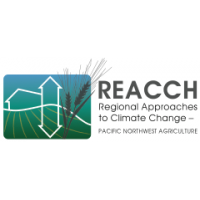Bromus tectorum (downy brome) is the mode wide spread weed species within the PNW small grain production region. Downy brome is a winter annual weed, requiring vernalization to reproduce. Climate change in the PNW is projected to lead to milder winters which may impact how downy brome develops and competes with crops in the region. In 2010 and 2011 over 100 accession of downy brome were collected throughout the PNW small grain production region. Of the collected accessions 96 were later transplanted into three common gardens located in 2013 at the Cook Agronomy Farm and USDA Central Ferry Research Station, and again at the Central Ferry station in 2014. At each location, panicles were collected weekly as plants matured. Collected panicles were later planted at the WSU plant growth facility and germination was recorded. A panicle that later germinated indicated that the panicle was mature at the time of collection, a panicle that did not germinate was not mature at the time of collection. Using the cumulative growing degrees (GDD) at the time of collection and the maturity of each panicle at the time of collection, maturity was regressed against GDD using a non-linear log-logistic regression model to estimate the GDD required to produce a mature panicle from each acc. The enclosed spreadsheets include the numbered downy brome accessions (acc) used in each experiment, the GPS coordinates and year of collection for each accession, the raw data from each experiment site indicating maturity of panicles (a binary response variable) at each sampling date, the regression parameters estimations for GDD required to produce 50% mature panicles per accession, the standard error of the estimates, and the upper and lower 95% confidence intervals of those estimates.
Data and Resources
| Field | Value |
|---|---|
| Modified | 2016-06-01 |
| Release Date | 2016-06-01 |
| Publisher | |
| Identifier | nkn:{1FD5C8BF-68B8-4A78-BFE4-A20A0DFB05DD} |
| Spatial / Geographical Coverage Location | -180,-90,180,90 |
| License | Creative Commons Attribution Non-Commercial Share-Alike (CC-BY-NC-SA 4.0) |
| Public Access Level | Public |
| POD Theme | geospatial biota |
| Harvest Source Title | REACCH PNA |
| Harvest Source URI | http://nknportal.nkn.uidaho.edu/final.json |
| Last Harvest Performed | Fri, 02/01/2019 - 17:30 |

